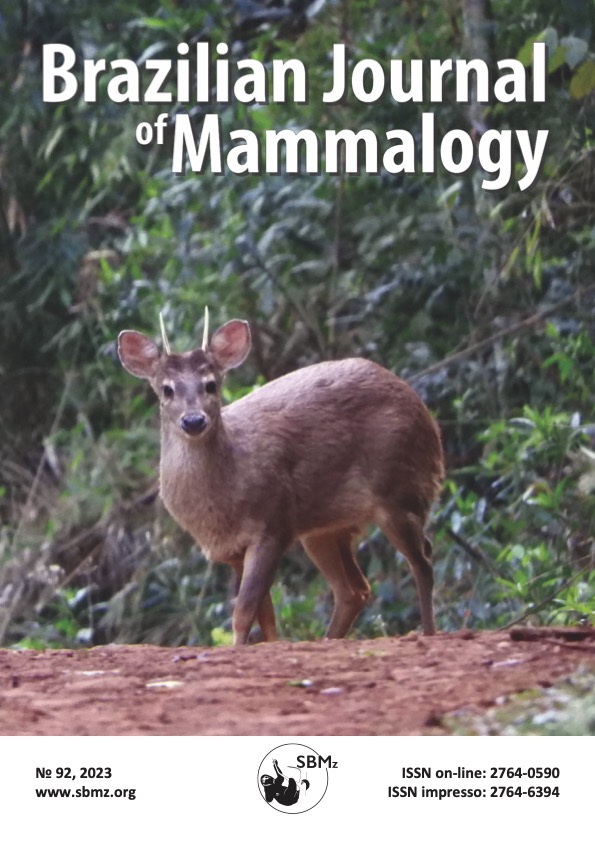Mundos pequeños
Un nuevo registro de la vulnerable Corzuela enana Mazama nana (Hensel, 1872) para el sur de Brasil
DOI:
https://doi.org/10.32673/bjm.vi92.86Palabras clave:
atropellamiento, ciervo, distribución, Bosque Atlántico, NeotropicalResumen
La cierva enana (Mazama nana) es una especie de ciervo pequeño y esquivo, endémico del sur de Sudamérica. Aunque está muy amenazada, su ecología y distribución están aún poco estudiadas. Informamos de un nuevo registro de una hembra atropellada, recopilamos los datos disponibles sobre su distribución y discutimos su distribución actual. Mostramos que M. nana está presente en ecoregiones forestales del sur de Brasil, este de Paraguay y norte de Argentina. Destacamos que el atropellamiento puede ser una causa descuidada de mortalidad y subrayamos la importancia de comunicar los datos de presencia de especies elusivas como M. nana.
Citas
Abril VV, Duarte JMB. 2008. Chromosome polymorphism in the Brazilian dwarf brocket deer, Mazama nana (Mammalia, Cervidae). Genetics and Molecular Biology 31: 53-57. DOI: https://doi.org/10.1590/S1415-47572008000100011.
Abril VV, Vogliotti A, Varela DM, Duarte JMB, Cartes JL. 2010. Brazilian dwarf brocket deer Mazama nana (Hensel 1872). Pp 160-165, In: Duarte JMB, Gonzales S (Eds.), Neotropical cervidology: neotropical cervidology biology and medicine of Latin American deer. Funep, Jaboticabal, Brazil.
Allen JA. 1915. Notes on American deer of the genus Mazama. Bulletin of the American Museum of Natural History 34: 521-553.
Azevedo NA, Oliveira ML, Duarte JMB. 2021. Guia ilustrado dos cervídeos brasileiros. Sociedade Brasileira de Mastozoologia, Rio de Janeiro. 41 pp.
Cáceres NC. 2011. Biological characteristics influence mammal road kill in an Atlantic Forest-Cerrado interface in south-western Brazil. Italian Journal of Zoology 78(3): 379-389. DOI: https://doi.org/10.1080/11250003.2011.566226.
Chebez JC, Varela D. 2001. Corzuela enana. Pp. 51-56, In: Dellafiore M, Macieira M (Eds.), Los ciervos autóctonos de la Argentina y la acción del hombre. Grupo Abierto Comunicaciones, Buenos Aires, Argentina.
Duarte JMB, González S, Maldonado JE. 2008. The surprising evolutionary history of South American deer. Molecular Phylogenetics and Evolution, 49(1): 17-22. https://doi.org/10.1016/j.ympev.2008.07.009.
Duarte JMB, Vogliotti A, Cartes JL, Oliveira ML. 2015. Mazama nana. The IUCN Red List of Threatened Species 2015: e.T29621A22154379. DOI: https://dx.doi.org/10.2305/IUCN.UK.2015-4.RLTS.T29621A22154379.en. Accessed on 08 November 2022.
Eisenberg JF, Redford KH. 1989. Mammals of the Neotropics, Volume 3: Ecuador, Bolivia, Brazil. University of Chicago Press, Chicago.
Hendges CD, Salvador CH, Nichele MA. 2015. Mamíferos de médio e grande porte de remanescentes de Floresta Estacional Decidual no Parque Estadual Fritz Plaumann e em áreas adjacentes, Sul do Brasil. Biotemas 28(3): 121-134. DOI: http://dx.doi.org/10.5007/2175-7925.2015v28n3p121.
Hübel M, Aximoff I, Freitas AC, Rosa C. 2011. Mamíferos de médio e grande porte na Área de Proteção Ambiental Municipal do Rio Vermelho em Santa Catarina, sul do Brasil. Oecologia Australis Ahead of print. DOI: http://dx.doi.org/10.4257/oeco.2021.2503.08.
Oliveira ML, Couto HTZ, Duarte JMB. 2019. Distribution of the elusive and threatened Brazilian dwarf brocket deer refined by non-invasive genetic sampling and distribution modelling. European Journal of Wildlife Research 65(2): 1-9. DOI: https://doi.org/10.1007/s10344-019-1258-6.
Oliveira ML, Grotta-Netto F, Faria Peres PH, Vogliotti A, Brocardo CR, Cherem JJ, Landis M, Paolino RM, Fusco-Costa R, Gatti A, Moreira DO. 2022. Elusive deer occurrences at the Atlantic Forest: 20 years of surveys. Mammal Research 67(1): 51-9. https://doi.org/10.1007/s13364-021-00604-4.
Preuss JF, Pfeifer GB, Toral JF, Bressan SJ. 2016. Levantamento rápido de mamíferos terrestres em um remanescente de Mata Atlântica do Sul do Brasil. Unoesc & Ciência 7(1): 89-96.
Serrano F, Pita R, Mota‐Ferreira M, Beja P, Segurado P. 2020. Landscape connectivity affects individual survival in unstable patch networks: The case of a freshwater turtle inhabiting temporary ponds. Freshwater Biology 65(3): 540-551. DOI: https://doi.org/10.1111/fwb.13449.
Serrano FC, Vieira-Alencar J, Diaz-Ricaurte JC, Valdujo P, Martins M, Nogueira C. 2023. The Wallacean Shortfall and the role of historical distribution records in the conservation assessment of an elusive Neotropical snake in a threatened landscape. Journal for Nature Conservation 72: 126350. DOI: https://doi.org/10.1016/j.jnc.2023.126350.
Tortato FR, Testoni AF, Althoff SL. 2014. Mastofauna terrestre da Reserva Biológica Estadual do Sassafrás, Doutor Pedrinho, Santa Catarina, Sul do Brasil. Biotemas 27(3): 123-129. DOI: https://doi.org/10.5007/2175-7925.2014v27n3p123.
Vogliotti A. 2008. Partição de habitats entre os cervídeos do Parque Nacional do Iguaçu. Doctoral dissertation in Applied Ecology (Agrosystem Ecology). Universidade de São Paulo, Piracicaba, São Paulo, Brazil. DOI: 10.11606/T.91.2009.tde-17032009-083126.
Weber M, Gonzalez S. 2003. Latin American deer diversity and conservation: a review of status and distribution. Ecoscience 10(4): 443-454. DOI: https://doi.org/10.1080/11956860.2003.11682792.
Yahnke CJ, Fox IG, Colman F. 1998. Mammalian species richness in Paraguay: the effectiveness of national parks in preserving biodiversity. Biological Conservation 84(3), 263-268. DOI: https://doi.org/10.1016/S0006-3207(97)00113-4.
Zizka A, Carvalho FA, Calvente A, Baez-Lizarazo MR, Cabral A, Coelho JF, Colli-Silva M, Fantinati MR et al. 2020. No one-size-fits-all solution to clean GBIF. PeerJ 8: e9916. https://doi.org/10.7717/peerj.9916.
Descargas
Publicado
Cómo citar
Número
Sección
Licencia
Derechos de autor 2023 Brazilian Journal of Mammalogy

Esta obra está bajo una licencia internacional Creative Commons Atribución 4.0.


